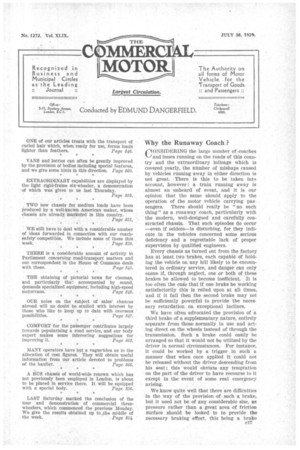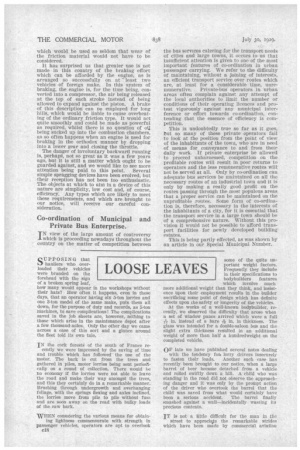Why the Runaway Coach.?
Page 39

Page 40

If you've noticed an error in this article please click here to report it so we can fix it.
CONSIDERING the large number of coaches and buses running on the roads of this country and the extraordinary Mileage which is covered yearly, the number of mishaps caused by vehicles running away in either direction is not great. There is this to be taken into account, however : a train running away is almost an unheard of event, and it is our opinion that the same should apply to the operation of the motor vehicle carrying pas. sengers. There should really be "no such thing" as a runaway coach, particularly with the modern, well-designed and carefully constructed chassis. That such episodes do occur —even if seldom—is disturbing, for they indicate in the vehicles concerned some serious deficiency and a regrettable lack of proper supervision by qualified engineers.
Every chassis as turned out from the factory has at least two brakes, each capable of holding the vehicle on any hill likely to be encountered in ordinary service, and danger can only ensue if, through neglect, one or both of these brakes be allowed to become inefficient. It is too often the cage that if one brake be working satisfactorily this is relied upon at all times, and if it fail then the second brake may not be sufficiently powerful to provide the necessary retardation on exceptional inclines.
We have often advocated the provision of a third brake of a supplementary nature, entirely separate from those normally in use and acting direct on the wheels instead of through the transmission. Such a brake could easily be arranged so that it would not be utilized by the driver in normal circumstances. For instance, it could be worked by a trigger in such a manner that when once applied it could not be released without the driver descending from his seat ; this would obviate any temptation on the part of the driver to have recourse to it except in the event of some real emergency arising.
We know quite well that there are difficulties In the way of the provision of such a brake, but it need not be of any considerable size, as pressure rather than a great area of friction surface should be looked to to provide the necessary braking effort. this being a brake which would be used so seldom that wear of the friction material would not have to be considered.
It has surprised us that greater use is not made in this country of the braking effort which can be afforded by the engine, as is arranged so successfully on at least two vehicles of foreign make. In this system of braking, the engine is, for the time being, converted into a compressor, the air being released at the top of each stroke instead of being allowed to expand against the piston. A brake of this description can De eniployed for long hills, which would be liable to cause overheating of the ordinary friction type. It would act quite smoothly and could be made as powerful as required, whilst there is no question of oil being sucked up into the combustion chambers, as so often happens when an engine is used for braking in the orthodox manner by dropping into a lower gear and closing the throttle. The danger of involuntary backward running is, perhaps, not so great as it was a few years ago, but it is still a matter which ought to be guarded against, and we would like to see more attention being paid to this point. Several simple spragging devices have been evolved, but their reception has not been too enthusiastic. The objects at which to aim in a device of this nature are simplicity, low cost and, of course, efficiency. Any types which are likely to meet these requirements, and which are brought to our notice, will receive our careful consideration.












































































































